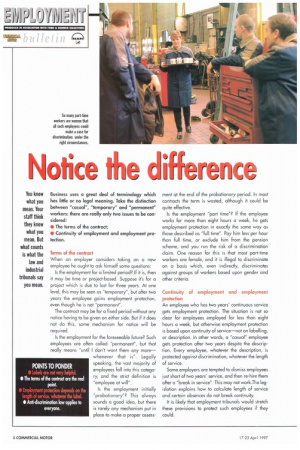Notice the difference
Page 78

If you've noticed an error in this article please click here to report it so we can fix it.
Business uses a great deal of terminology which has little or no legal meaning. Take the distinction between "casual", "temporary" and "permanent" workers: there are really only two issues to be considered: • The terms of the contract; • Continuity of employment and employment protection.
Terms of the contract When an employer considers taking on a new employee he ought to ask himself some questions:
Is the employment for a limited period? If it is, then it may be time or project-based. Suppose it's for a project which is due to last for three years. At one level, this may be seen as "temporary", but after two years the employee gains employment protection, even though he is not "permanent".
The contract may be for a fixed period without any notice having to be given on either side. But if it does not do this, some mechanism for notice will be required.
Is the employment for the foreseeable future? Such employees are often called "permanent", but that really means "until I don't want them any more— whenever that is". Legally speaking, the vast majority of employees fall into this category, and the strict definition is "employee at will".
POINTS TO PONDER
are not very helpful.
Is the employment initially "probationary"? This always sounds a good idea, but there is rarely any mechanism put in place to make a proper assess
ment at the end of the probationary period. In most contracts the term is wasted, although it could be quite effective.
Is the employment "part time"? If the employee works for more than eight hours a week, he gets employment protection in exactly the same way as those described as "full time". Pay him less per hour than full time, or exclude him from the pension scheme, and you run the risk of a discrimination claim. One reason for this is that most part-time workers are female, and it is illegal to discriminate on a basis which, even indirectly, discriminates against groups of workers based upon gender and other criteria.
Continuity of employment and employment protection
An employee who has two years' continuous service gets employment protection. The situation is not so clear for employees employed for less than eight hours a week, but otherwise employment protection is based upon continuity of service—not on labelling, or description. In other words, a "casual" employee gets protection after two years despite the description. Every employee, whatever the description, is protected against discrimination, whatever the /ength of service.
Some employers are tempted to dismiss employees just short of two years' service, and then re-hire them after a "break in service", This may not work.The legislation explains how to calculate length of service and certain absences do not break continuity.
It is likely that employment tribunals would stretch these provisions to protect such employees if they could.




















































































































